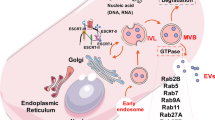Abstract
Background
Cancer cell mediated vascular endothelial cell (vEC) retraction plays a pivotal role in cancer metastasis. The aim of this study is to clarify the biochemical character of vEC retraction factor derived from human breast cancer cell line, MCF-7.
Methods and Results
In order to estimate vEC retracting activity, transwell chamber assay system was employed. We first tested the effects of trypsin digestion as well as lipid extraction of culture medium (CM). Trypsin digestion of CM resulted in approximately 40% loss of vEC retracting activity and lipid extraction of CM by Brigh and Dyer methods recovered approximately 60% of vEC retracting activity, suggesting that approximately 60% of vEC retracting activity in MCF-7 derived CM is due to lipid. Although Nordihydroguaiaretic acid (NDGA), the specific lipoxygenase inhibitor, suppressed vEC retracting activity in CM, Acetyl salicylic acid (ASA), a specific cyclooxygenase inhibitor, did not affect the activity, suggesting that lipid exerting vEC retracting activity in CM belongs to lipoxygenase mediated arachidonate metabolites. Thin layer chromatography clearly demonstrated that Rf value of lipid vEC retracting factor in CM is identical to 12HETE. Authentic 12(S)HETE, but not 12(R)HETE, showed vEC retracting activity. After the ultracentrifugation of CM, most lipid vEC retracting activity was recovered from the pellet fraction, and flow cytometric analysis using specific antibody against 12(S)HETE clearly showed the association of 12(S)HETE with small particle in CM.
Conclusion
These findings suggested the principal involvement of 12(S)HETE in cancer cell derived microparticles in cancer cell mediated vEC retraction.









Similar content being viewed by others
References
Fidler IJ, Gerstein DM, Hart IR. The biology of cancer invasion and metastasis.Advanc Cancer Res 1978; 28:149–250
Nicolson GL. Organ colonization and the cell-surface properties of malignant cells. Biochem biophys Acta 1982; 695:113–76
Carr I, McGinty F, Norris P. The fine structure of neoplastic invasion:invasion of liver,skeletal muscle and lymphatic vessels by the Rd/3 tumour. J pathol 1976; 118:91–99
Akedo H, Shinkai K, Mukai M, et al. Interaction of rat ascites hepatoma cells with cultured mesothelial cell layers:a model for tumor invasion. Cancer Res 1986; 46:2416–22
Ohigashi H, Shinkai K, Mukai M, et al. In vitro invasion of endothelial cell monolayer by rat ascites hepatoma cells. Jpn J Cancer Res 1989; 80:818–21
Zetter BR. Adhesion molecules in tumor metastasis. Semin Cancer Biol Aug 1993; 4(4):219–29
Nakamori S, Okamoto H, et.al. Increased endothelial cell retraction and tumor cell invasion by soluble factors derived from pancreatic cancer cells. Ann Surg Oncol 1997; 4:361–368
Shibuya M. Angiogenesis–vascular endothelial growth factor and its receptors. Hum Cell 1999; 12(1):17–24
David M, Humphrey Linda M, McManus, Kiyoshi Satoguchi, et al. Vasoactive Properties of Acetyl Glyceryl Ether Phosphorylcholine and Analogues. Lab Invest 1982; 42:422–427
Kusama T, Nakamori S, et al. Enhancement of in vitro tumor-cell transcellular migration by tumor-cell-secreted endothelial-cell-retraction factor. Int J Cancer 1995; 63:112–118
Bligh EG, Dyer WJ. A rapid method of total lipid extraction and purification. Can J Bioch Physiol 1959; 37:911–917
Okuma M, Uchino H. Altered arachidonate metabolism by platelets in patients with myeloproliferative disorders. Blood 1979; 54(6):1258–71
Yamamoto T, Nagano H, Sakon M, et al. Partial contribution of tumor necrosis factor-related apoptosis-inducing ligand (TRAIL)/TRAIL receptor pathway to antitumor effects of interferon-alpha/5-fluorouracil against Hepatocellular Carcinoma. Clin Cancer Res 2004; 10(23):7884–95
Majno G, Palade GE. Studies on inflammation. 1. The effect of histamine and serotonin on vascular permeability: an electron microscopic study. J Biophys Biochem Cytol 1961; 11:571–605
Dahlen SE, Jakob Bjork, Per Hedqvist, et al. Leukotrienes promote plasma leakage and leukocyte adhesion in postcapillary venules. Proc Natl Acad Sci 1988; 78:3887–3891
Rabiet MJ, Plantier JL, Rival Y, et al. Thrombin-induced increase in endothelial permeability is associated with changes in cell-to-cell junction organization. Arterioscler Thromb Vasc Biol 1996; 16(3):488–96
Burke-Gaffney A, Keenan AK. Modulation of human endothelial cell permeability by combinations of the cytokines interleukin-1 alpha/beta, tumor necrosis factor-alpha and interferon-gamma. Immunopharmacology 1993; 25(1):1–9
Maruo N, Morita I, Shirao M, et al. IL-6 increases endothelial permeability in vitro. Endocrinology 1992; 131(2):710–4
Schraufstatter IU, Chung J, Burger M. IL-8 activates endothelial cell CXCR1 and CXCR2 through Rho and Rac signaling pathways. Am J Physiol Lung Cell Mol Physiol 2001; 280(6):1094–1103
Horvath CJ, Ferro J, Thomas, Jesmok Gary, et al. Recombinant tumor necrosis factor increase pulmonary vascular permeability independent of neutrophils. Proc Natil Acad Sci 1988; 85:9219–9223
Kenneth V, Honn Dean G, Tang, et al. Tumo cell-derived 12(S)-hydroxyeicosatetraenoic acid induces microvascular endothelial cell retraction. Cancer Research 1994; 54:565–574
Kenneth V, Honn Irma M, Grossi, et al. Enhanced tumor cell adhesion to the subendothelial matrix resulting from 12(S)-HETE-induced endothelial cell retraction. The FASEB J 1989; 2285–2293
Iwamoto S, Kawasaki T, Kambayashi J, et al. Platelet Microparticles: A carrier of Platelet-Activating Factor? Biochem Biophys Res Commun 1996; 218(3):940–944
Author information
Authors and Affiliations
Corresponding author
Rights and permissions
About this article
Cite this article
Uchide, K., Sakon, M., Ariyoshi, H. et al. Cancer Cells Cause Vascular Endothelial Cell (vEC) Retraction via 12(S)HETE Secretion; The Possible Role of Cancer Cell Derived Microparticle. Ann Surg Oncol 14, 862–868 (2007). https://doi.org/10.1245/s10434-006-9225-3
Received:
Revised:
Accepted:
Published:
Issue Date:
DOI: https://doi.org/10.1245/s10434-006-9225-3




